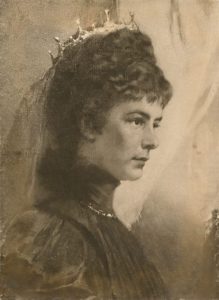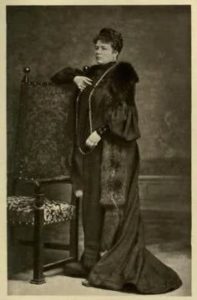by Greg King and Penny Wilson
By 1918, the Austro-Hungarian and the German Empires had collapsed into nothingness. Imperial families were stripped of their titles and relegated to the status of citizen; their laws and traditions were wiped away and—absent the suffocating censorship of their former rulers—artists, musicians, playwrights, and writers burst forth with a wave of creativity as they explored previously banned historical and cultural subjects. At the same time, attracted by the combination of this immediate post-war artistic excitement and middle Europe’s gorgeous scenery, motion-picture companies descended on the larger cities, including Munich in the former kingdom of Bavaria.

One of these companies was Indra Films. An initial press-release announced their intention to make a movie about the events at Mayerling in January 1889, when the Austrian Crown Prince Rudolf and his teenaged girlfriend, Baroness Marie Vetsera, died one mysterious and tragic night. A shiver of excitement ran through the Munich: Rudolf had been the son of a Bavarian Duchess, and the tragedy had never been explained to the public’s satisfaction. Books and magazine articles on the subject still sold extremely well, and it remained an item of gossip in coffee houses and across tea-tables.
For the former noblewoman Marie Larisch, the news of the film was a godsend. She had fallen far even before the War stripped away her noble status. Larisch had been the niece of Empress Elisabeth of Austria, the mother of the tragic Crown Prince. And unfortunately for her, she had been an intimate friend of both Rudolf and Marie Vetsera; in the immediate wake of Mayerling, she’d been left holding the bag. Unable to explain anything without digging herself in deeper, Marie found herself blamed by the Empress for the death of her son. She was banished from the Empress’s presence and never saw her again. This had been a severe blow: Marie had worshipped her beautiful and mysterious aunt, and the loss was magnified by the fact that Viennese society had also turned their backs on her. To be fair, Marie had often made liking her difficult; her arrogance, her sense of entitlement, and her unsavory activities with Rudolf’s fast set had put a target on her, and all of Vienna was only too happy to be rid of this disturbed and disturbing young woman.

And so, in order to escape what became a very lonely life, Marie left Austria and returned to her homeland of Bavaria, where she remained through the first two decades of the twentieth century, living a life far different from the one of Imperial luxury that she had once been used to. By the time Indra Films arrived in Munich, Marie had nothing to her name except her experiences in life, and she was ready to use them to make some money. She visited Indra’s owner, Rolf Raffe, offering copies of her memoirs of Mayerling and the Austrian Court to confirm her expertise before suggesting that she serve as an advisor to his production.
Raffe hired Marie and together, they created something very special. “It was a wonderful collaboration,” wrote Raffe in his 1977 memoirs, “And the film ‘Crown Prince Rudolf, or The Secret of Mayerling’ was an audience success of the very first rank.” Marie herself wrote the entire screenplay, and much of it was directed according to her advice.
It can be assumed that Marie’s Habsburg relatives greeted her creation with some combination of anger and disappointment. Such a popular topic was bound to inspire more books and films, and indeed, eighteen months later, in November 1921, Helios Films produced “Crown Prince Rudolf, The Mystery at Mayerling.” This film was unofficially banned in Vienna in deference to the wishes of Rudolf’s daughter, Archduchess Elisabeth, who insisted, “it contradicts decency and good manners to film occurrences from private life.” This was a singular event, an odd sort of throw-back to Imperial days, and the Archduchess was not able to improve on this ban of a single movie.
Marie’s film career flourished for some time. She even gained a nickname in film circles: Vio. She collaborated again with Raffe on the production of a second film about her family, “Silence at Lake Starnberg.” This movie was about another mysterious death, this time, that of Marie’s royal cousin, Ludwig II King of Bavaria.
Again, Marie wrote the screenplay for the movie – but this time she managed to make the film stand out even more by using her family ties to gain permission to film part of the movie at Ludwig’s private residence, Schloss Herrenchiemsee.
“Silence at Lake Starnberg” was believed to have been lost for many years, but in the mid-1970s, a single copy of the film, labeled “Silence at the Lake of Starnberg – Fateful Days of King Ludwig II” was found in the Soviet Union. It was returned to Munich, where it was screened for an enthusiastic crowd at the city museum in 1978; present at the screening was 81-year-old Carla Nelsen, who had appeared in the film in the role of Empress Elisabeth. She shared colorful remembrances of making the film at Herrenchiemsee, including the day a large snake invaded the palace and caused pandemonium on the set.

Suddenly, the Habsburg family was in vogue, and a third film on Marie’s family was proposed. This one was considerably closer to her heart as it was to be about the murder of her aunt, the Empress Elisabeth, by the anarchist Luigi Lucheni in Switzerland in 1898. Marie did not write this screenplay, but in a rather unusual move, she was selected – at the age of sixty-three – to play her thirty-year-old self in the film. Less than thirty seconds of this film exists today, and it shows only Elisabeth’s deathbed scene, so we are unable to judge how successful a Countess Larisch Countess Larisch really was!
Marie’s major responsibility in this film was the instruction of its star in the art of being Elisabeth. Marie later wrote to the actress Elissa Landi (rumored to be a granddaughter of Elisabeth through an illegitimate daughter) that, “My Elisabeth, the young Carla, was not a star, but she was a great success, in her refined simplicity, and I was able to teach her the role so well, and she was able to shape the mask quite similarly. The Princess Gisela [Elisabeth’s eldest daughter], who watched the movie, was said to have cried about the resemblance! The final scene was shot in Geneva in the same room where it all happened, and everything remained as it was then…”
 Unfortunately for Marie Larisch, movie careers were as fickle in the 1920s as they remain today; “Empress Elisabeth of Austria” was her last film, and by 1924, the former Countess was again on the mercy of others, this time a third husband, an American, who beat her. By the late 1930s, she was extremely poor and living in Augsburg, where she died in 1941, the last remnant of the tragedy at Mayerling.
Unfortunately for Marie Larisch, movie careers were as fickle in the 1920s as they remain today; “Empress Elisabeth of Austria” was her last film, and by 1924, the former Countess was again on the mercy of others, this time a third husband, an American, who beat her. By the late 1930s, she was extremely poor and living in Augsburg, where she died in 1941, the last remnant of the tragedy at Mayerling.
GREG KING is the author of several internationally published works of history, including The Assassination of the Archduke. He serves as Editor-in-Chief of the European Royal History Journal, and his work has appeared in Majesty Magazine, Royalty Magazine, Royalty Digest, and Atlantis Magazine.
PENNY WILSON is the coauthor (with Greg King) of such histories on late Imperial Russia as The Fate of the Romanovs and The Resurrection of the Romanovs. Her historical work has appeared in Majesty Magazine, Atlantis Magazine, and Royalty Digest.
